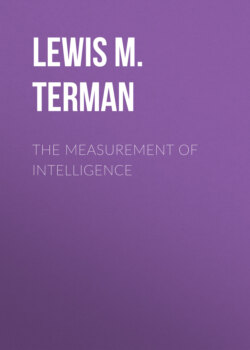Читать книгу The Measurement of Intelligence - Lewis M. Terman - Страница 40
На сайте Литреса книга снята с продажи.
Method of arriving at a revision.
ОглавлениеTable of Contents
The revision of the scale below the 14-year level was based almost entirely on the tests of the above-mentioned 1,000 unselected children. The guiding principle was to secure an arrangement of the tests and a standard of scoring which would cause the median mental age of the unselected children of each age group to coincide with the median chronological age. That is, a correct scale must cause the average child of 5 years to test exactly at 5, the average child at 6 to test exactly at 6, etc. Or, to express the same fact in terms of intelligence quotient,[16] a correct scale must give a median intelligence quotient of unity, or 100 per cent, for unselected children of each age.
If the median mental age resulting at any point from the provisional arrangement of tests was too high or too low, it was only necessary to change the location of certain of the tests, or to change the standard of scoring, until an order of arrangement and a standard of passing were found which would throw the median mental age where it belonged. We had already become convinced, for reasons too involved for presentation here, that no satisfactory revision of the Binet scale was possible on any theoretical considerations as to the percentage of passes which an individual test ought to show in a given year in order to be considered standard for that year.
As was to be expected, the first draft of the revision did not prove satisfactory. The scale was still too hard at some points, and too easy at others. In fact, three successive revisions were necessary, involving three separate scorings of the data and as many tabulations of the mental ages, before the desired degree of accuracy was secured. As finally revised, the scale gives a median intelligence quotient closely approximating 100 for the unselected children of each age from 4 to 14.
Since our school children who were above 14 years and still in the grades were retarded left-overs, it was necessary to base the revision above this level on the tests of adults. These included 30 business men and 150 “migrating” unemployed men tested by Mr. H. E. Knollin, 150 adolescent delinquents tested by Mr. J. Harold Williams, and 50 high-school students tested by the writer.
The extension of the scale in the upper range is such that ordinarily intelligent adults, little educated, test up to what is called the “average adult” level. Adults whose intelligence is known from other sources to be superior are found to test well up toward the “superior adult” level, and this holds whether the subjects in question are well educated or practically unschooled. The almost entirely unschooled business men, in fact, tested fully as well as high-school juniors and seniors.
Figure 1 shows the distribution of mental ages for 62 adults, including the 30 business men and the 32 high-school pupils who were over 16 years of age. It will be noted that the middle section of the graph represents the “mental ages” falling between 15 and 17. This is the range which we have designated as the “average adult” level. Those above 17 are called “superior adults,” those between 13 and 15, “inferior adults.” Subjects much over 15 years of age who test in the neighborhood of 12 years may ordinarily be considered border-line cases.
| Fig. 1. DISTRIBUTION OF MENTAL AGES OF 62 NORMAL ADULTS | ||||
| 13 to 13 11 | 14 to 14 11 | 15 to 15 11 | 17 to 17 11 | 18 to 18 11 |
|---|---|---|---|---|
| 1.6% | 17.7% | 59.7% | 16.2% | 4.8% |
The following method was employed for determining the validity of a test. The children of each age level were divided into three groups according to intelligence quotient, those testing below 90, those between 90 and 109, and those with an intelligence quotient of 110 or above. The percentages of passes on each individual test at or near that age level were then ascertained separately for these three groups. If a test fails to show a decidedly higher proportion of passes in the superior I Q group than in the inferior I Q group, it cannot be regarded as a satisfactory test of intelligence. On the other hand, a test which satisfies this criterion must be accepted as valid or the entire scale must be rejected. Henceforth it stands or falls with the scale as a whole.
When tried out by this method, some of the tests which have been most criticized showed a high degree of reliability; certain others which have been considered excellent proved to be so little correlated with intelligence that they had to be discarded.
After making a few necessary eliminations, 90 tests remained, or 36 more than the number included in the Binet 1911 scale. There are 6 at each age level from 3 to 10, 8 at 12, 6 at 14, 6 at “average adult,” 6 at “superior adult,” and 16 alternative tests. The alternative tests, which are distributed among the different groups, are intended to be used only as substitutes when one or more of the regular tests have been rendered, by coaching or otherwise, undesirable.[17]
Of the 36 new tests, 27 were added and standardized in the various Stanford investigations. Two tests were borrowed from the Healy-Fernald series, one from Kuhlmann, one was adapted from Bonser, and the remaining five were amplifications or adaptations of some of the earlier Binet tests.
Following is a complete list of the tests of the Stanford revision. Those designated al. are alternative tests. The guide for giving and scoring the tests is presented at length in Part II of this volume.
